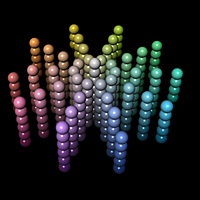How Many Dimensions Are Required to Describe Color Appearance?
Most would answer this question with the number three. After all, even this website can be quoted as saying that three is the most important number in color science. The visual system has three types of cone photoreceptors, we can describe objects with three appearance attributes (lightness, chroma, and hue), and we can make metameric matches to objects with just three primary colors (as in color television). There are also a plethora of three-dimensional color spaces used in various aspects of color science and technology. So how could the answer be anything other than three? It is, the correct answer is that it takes more than three dimensions to full describe color appearance and the most probable number is five.
There are actually six distinct terms that are used to describe color appearance. These are brightness, lightness, colorfulness, chroma, saturation, and hue. So if all six of these dimensions are independent, then it would take six dimensions to describe color appearance. In reality, colorfulness, chroma, and saturation are inter-related in such a way that only two of those three are required for a full description of appearance. Thus, the final answer that five dimensions are required to describe color appearance. There are a class of color spaces, known as color appearance models, that include all six of these dimensions. While there might be alternative viable theories of color perception, it is clear that the overall description does require more than three dimensions and that is due to our ability to perceive attributes about the illumination environment in addition to the relative color attributes of objects. The definitions of the perceptual dimensions are given below.
All of the dimensions are attributes of visual perception (recall that color is a perception, not a physical quantity). Brightness is our perception of the amount of light coming from a stimulus. Lightness is the brightness of a stimulus relative to something that looks white under the same illumination (lightness is relative brightness). Colorfulness is our perception of how much hue content (difference from neutral gray, black, or white) is present in the stimulus. Saturation is colorfulness relative to the brightness of the stimulus (like lightness is relative brightness, saturation is relative colorfulness). Next, chroma is colorfulness relative to the brightness of a similarly illuminated white (again, chroma is relative colorfulness, but in a sense different from saturation). Saturation and chroma describe similar dimensions of appearance, but in different ways. For the mathematically inclined, chroma can be thought of as the an expression of colorfulness in cylindrical coordinates while saturation expresses the same information in conical coordinates. Lastly, hue is the attribute of appearance that is often colloquially called "color". Hue is the similarity to red, green, yellow, or blue, which are all examples of hue names.
![]()
Explore the NEXT TOPIC at this level.
There are no more levels to explore! Congratulations for reaching the top. If you are interested in more, these discussions of NUMBERS fall under the scientific discipline of MATHEMATICS.
Ever wonder ... What is adaptation?
Updated: Apr. 19, 2011

